23 apr 2018 Land day
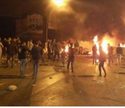
Israeli soldiers invaded, on Monday evening, Abu Dis town, southeast of occupied East Jerusalem, and fired many live rounds, rubber-coated steel bullets and gas bombs, causing scores on injuries, including some who were shot with live bullets.
Media sources in Abu Dis said the soldiers attacked dozens of Palestinians who protested the invasion into the Schools’ Street, and around the Al-Quds University.
The army fired many live rounds, rubber-coated steel bullets and gas bombs at the protesters, wounding many, including some who were shot with live rounds, and causing scores to suffer the effects of teargas inhalation.
The invasion was the second in less than 24 hours, after the soldiers invaded the town, and fired dozens of concussion grenades, gas bombs and live rounds at local youngsters, who hurled stones at them.
Many Palestinians were injured, some with live rounds.
In related news, the soldiers abducted, on Monday evening, a young man, identified as Rashid Resheq, after invading and searching his home in the Old City of Jerusalem, and took him to an interrogation facility.
Media sources in Abu Dis said the soldiers attacked dozens of Palestinians who protested the invasion into the Schools’ Street, and around the Al-Quds University.
The army fired many live rounds, rubber-coated steel bullets and gas bombs at the protesters, wounding many, including some who were shot with live rounds, and causing scores to suffer the effects of teargas inhalation.
The invasion was the second in less than 24 hours, after the soldiers invaded the town, and fired dozens of concussion grenades, gas bombs and live rounds at local youngsters, who hurled stones at them.
Many Palestinians were injured, some with live rounds.
In related news, the soldiers abducted, on Monday evening, a young man, identified as Rashid Resheq, after invading and searching his home in the Old City of Jerusalem, and took him to an interrogation facility.
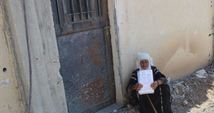
Israeli soldiers invaded, on Sunday at night, Hamsa al-Foqa Bedouin village in the West Bank’s Northern Plains and handed five families military orders informing them of intentions for hold live fire training in their area, and ordering them to leave on scheduled dates.
The soldiers ordered the families of Yasser, Abdullah, Adel and Taiseer Abu Kabbash, to leave their homes and dwellings on Tuesday, April 24th, May 1st and May 10th, from six in the morning until twelve in the afternoon.
It is worth mentioning that the army frequently displaces families in the area, and various parts of the Jordan Valley in addition to certain parts of the occupied West Bank, to hold live fire military drills.
Last month, the soldiers displaced two Palestinian Bedouin families from their homes in Khirbat Ibzeeq village, northeast of Tubas, in northeastern West Bank.
In January of this year, the soldiers shot a Palestinian child with a live round in the head, during “military training” near Tubas.
In many incidents, Palestinian families are ordered to leave their communities during the military drills, and later return after the army is done with its live-fire training, including the use of explosives, which are sometimes left behind, leading to casualties, including fatalities.
The soldiers ordered the families of Yasser, Abdullah, Adel and Taiseer Abu Kabbash, to leave their homes and dwellings on Tuesday, April 24th, May 1st and May 10th, from six in the morning until twelve in the afternoon.
It is worth mentioning that the army frequently displaces families in the area, and various parts of the Jordan Valley in addition to certain parts of the occupied West Bank, to hold live fire military drills.
Last month, the soldiers displaced two Palestinian Bedouin families from their homes in Khirbat Ibzeeq village, northeast of Tubas, in northeastern West Bank.
In January of this year, the soldiers shot a Palestinian child with a live round in the head, during “military training” near Tubas.
In many incidents, Palestinian families are ordered to leave their communities during the military drills, and later return after the army is done with its live-fire training, including the use of explosives, which are sometimes left behind, leading to casualties, including fatalities.
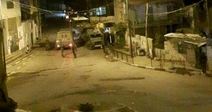
Dozens of Palestinians were injured Monday morning as clashes broke out in Abu Dis village east of occupied Jerusalem.
Local activist Hani Halabia said that the clashes erupted when Israeli forces stormed the village early today to seal holes locals have drilled in Israel’s apartheid wall built to separate the town from the occupied city.
Heavy teargas bombs and rubber bullets were fired by Israeli forces, while local youths responded with throwing stones and setting fire to tires.
Dozens of locals suffered different injuries and teargas inhalation during the clashes.
Following the confrontation, Abu Dis University suspended classes, citing safety of students and staff as its reason.
Israeli Soldiers Abduct Twenty-Three Palestinians In The West Bank
Israeli soldiers abducted, on Monday at dawn, at least twenty-three Palestinians from their homes in several parts of the occupied West Bank, including nine who were abducted in Jerusalem.
The Jenin office of the Palestinian Prisoners’ Society (PPS), in northern West Bank, said the soldiers stormed and ransacked many homes in the governorate, and abducted five Palestinians, including two siblings who are also former political prisoners.
It said the soldiers abducted Ahmad Mohammad Sa’adi, his brother, Noureddin, in addition to Firas Hani al-Ghoul, Mohammad Bani Ghorra and Mahmoud Ali Sa’adi.
In Qalqilia, also in northern West Bank, the soldiers abducted two young men, in their twenties, from their homes in the city.
Media sources said the soldiers assaulted and injured Mohammad Zoheir Eshteiwi and Mahmoud Abu Tayyim, before abducting them.
Furthermore, the soldiers invaded Qarawat Bani Hassan town, west of Salfit in northwestern West Bank, and abducted Adnan Mer’ey, 21, after storming his home and searching it.
In Hebron, in the southern part of the West Bank, the soldiers invaded Halhoul town, north of the city, searched many homes and abducted Mamdouh Hasan Abu Asba, 25. Mohammad Adnan al-Baba, Ali Sobhi al-Baba, 30, and his brother Mahmoud.
Th soldiers also abducted Mohammad Taiseer al-Badawi, from his home in the al-Arroub refugee camp, north of Hebron, and Haitham Mreish, from his home in Hebron city.
In addition, the soldiers invaded the towns of Ethna, Halhoul, Doura and Yatta, and many neighborhoods in Hebron city, before installing roadblocks, stopping and searching dozens of cars, and interrogated many Palestinians while inspecting their ID cards.
In occupied Jerusalem, dozens of soldiers invaded the al-‘Isawiya town and Shu’fat refuge camp, also searched many homes and abducted nine Palestinians.
The abducted residents have been identified as Hussein Shadi Obeid (child), Qussai Dari, Adam Fadi Mustafa, Adham Sabta, ‘Esmat ‘Obeid, Mohammad Marwan ‘Obeid, and ‘Odai Ayman, Mohammad, from al-‘Isawiya, in addition to Tha’er ad-Dabet and Monther Najjar, from Shu’fat refugee camp.
On Monday morning, the soldiers invaded the Schools Street and the areas around the al-Quds University in Abu Dis town, southeast of Jerusalem, and injured several Palestinians with live fire and rubber-coated steel bullets, in addition to causing many to suffer the effects of teargas inhalation, after the locals protested the invasion.
In related news, Israeli army bulldozers invaded Palestinian lands, north of Beit Lahia town, in the northern part of the Gaza Strip, and uprooted sections near the border fence, in addition to installing sand hills.
Local activist Hani Halabia said that the clashes erupted when Israeli forces stormed the village early today to seal holes locals have drilled in Israel’s apartheid wall built to separate the town from the occupied city.
Heavy teargas bombs and rubber bullets were fired by Israeli forces, while local youths responded with throwing stones and setting fire to tires.
Dozens of locals suffered different injuries and teargas inhalation during the clashes.
Following the confrontation, Abu Dis University suspended classes, citing safety of students and staff as its reason.
Israeli Soldiers Abduct Twenty-Three Palestinians In The West Bank
Israeli soldiers abducted, on Monday at dawn, at least twenty-three Palestinians from their homes in several parts of the occupied West Bank, including nine who were abducted in Jerusalem.
The Jenin office of the Palestinian Prisoners’ Society (PPS), in northern West Bank, said the soldiers stormed and ransacked many homes in the governorate, and abducted five Palestinians, including two siblings who are also former political prisoners.
It said the soldiers abducted Ahmad Mohammad Sa’adi, his brother, Noureddin, in addition to Firas Hani al-Ghoul, Mohammad Bani Ghorra and Mahmoud Ali Sa’adi.
In Qalqilia, also in northern West Bank, the soldiers abducted two young men, in their twenties, from their homes in the city.
Media sources said the soldiers assaulted and injured Mohammad Zoheir Eshteiwi and Mahmoud Abu Tayyim, before abducting them.
Furthermore, the soldiers invaded Qarawat Bani Hassan town, west of Salfit in northwestern West Bank, and abducted Adnan Mer’ey, 21, after storming his home and searching it.
In Hebron, in the southern part of the West Bank, the soldiers invaded Halhoul town, north of the city, searched many homes and abducted Mamdouh Hasan Abu Asba, 25. Mohammad Adnan al-Baba, Ali Sobhi al-Baba, 30, and his brother Mahmoud.
Th soldiers also abducted Mohammad Taiseer al-Badawi, from his home in the al-Arroub refugee camp, north of Hebron, and Haitham Mreish, from his home in Hebron city.
In addition, the soldiers invaded the towns of Ethna, Halhoul, Doura and Yatta, and many neighborhoods in Hebron city, before installing roadblocks, stopping and searching dozens of cars, and interrogated many Palestinians while inspecting their ID cards.
In occupied Jerusalem, dozens of soldiers invaded the al-‘Isawiya town and Shu’fat refuge camp, also searched many homes and abducted nine Palestinians.
The abducted residents have been identified as Hussein Shadi Obeid (child), Qussai Dari, Adam Fadi Mustafa, Adham Sabta, ‘Esmat ‘Obeid, Mohammad Marwan ‘Obeid, and ‘Odai Ayman, Mohammad, from al-‘Isawiya, in addition to Tha’er ad-Dabet and Monther Najjar, from Shu’fat refugee camp.
On Monday morning, the soldiers invaded the Schools Street and the areas around the al-Quds University in Abu Dis town, southeast of Jerusalem, and injured several Palestinians with live fire and rubber-coated steel bullets, in addition to causing many to suffer the effects of teargas inhalation, after the locals protested the invasion.
In related news, Israeli army bulldozers invaded Palestinian lands, north of Beit Lahia town, in the northern part of the Gaza Strip, and uprooted sections near the border fence, in addition to installing sand hills.
20 apr 2018 Land day
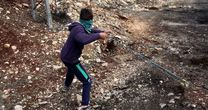
Dozens of Palestinians were injured on Friday during confrontations with the Israeli occupation forces (IOF) in different West Bank provinces.
Two Palestinian youths were injured by rubber-coated metal bullets during clashes in Bab al-Zawiya area in al-Khalil city.
Other clashes were witnessed in al-Bireh, Bil'in, al-Mazra'a al-Gharbiya and Nabi Saleh in Ramallah during which the Palestinian youths set dozens of tires on fire, raised Palestinian flags and chanted slogans condemning the Israeli crimes.
Following clashes between Palestinian citizens and Israeli settlers, the IOF stormed Burqa town in Ramallah, raided some Palestinian houses and wreaked havoc on them.
Dozens of Palestinians chocked on tear gas while an eight-year-old child was injured after being hit with a rubber-coated metal bullet during the weekly demonstration in Kafr Qaddum east of Qalqilya.
Further, the IOF soldiers were deployed in large numbers at the entrance of Azzun town east of Qalqilya. They arbitrarily stopped a number of Palestinian cars and searched them.
Dozens of suffocation cases were reported during clashes in Beita, Kafr Qalil and Huwara towns in Nablus.
Hundreds of Palestinian took to the streets following Friday prayer to participate in protests launched all over the West Bank and Jerusalem in support of the Great March of Return in Gaza.
Two Palestinian youths were injured by rubber-coated metal bullets during clashes in Bab al-Zawiya area in al-Khalil city.
Other clashes were witnessed in al-Bireh, Bil'in, al-Mazra'a al-Gharbiya and Nabi Saleh in Ramallah during which the Palestinian youths set dozens of tires on fire, raised Palestinian flags and chanted slogans condemning the Israeli crimes.
Following clashes between Palestinian citizens and Israeli settlers, the IOF stormed Burqa town in Ramallah, raided some Palestinian houses and wreaked havoc on them.
Dozens of Palestinians chocked on tear gas while an eight-year-old child was injured after being hit with a rubber-coated metal bullet during the weekly demonstration in Kafr Qaddum east of Qalqilya.
Further, the IOF soldiers were deployed in large numbers at the entrance of Azzun town east of Qalqilya. They arbitrarily stopped a number of Palestinian cars and searched them.
Dozens of suffocation cases were reported during clashes in Beita, Kafr Qalil and Huwara towns in Nablus.
Hundreds of Palestinian took to the streets following Friday prayer to participate in protests launched all over the West Bank and Jerusalem in support of the Great March of Return in Gaza.
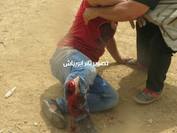
Israeli soldiers shot, Friday, a Palestinian child with live fire, and caused many to suffer the effects of teargas inhalation, in the al-Lubban ash-Sharqiya village, south of the northern West Bank city of Nablus.
The soldiers assaulted the Palestinians who marched in their village, protesting the ongoing illegal Israeli occupation of Palestine, and the escalating violations against them, their property and holy sites.
Medical sources said the soldiers shot the child, 16, with a live round in his leg, before he was rushed to Salfit governmental hospital.
The soldiers also fired many gas bombs and concussion grenades, causing many Palestinians to suffer the effects of teargas inhalation.
The soldiers assaulted the Palestinians who marched in their village, protesting the ongoing illegal Israeli occupation of Palestine, and the escalating violations against them, their property and holy sites.
Medical sources said the soldiers shot the child, 16, with a live round in his leg, before he was rushed to Salfit governmental hospital.
The soldiers also fired many gas bombs and concussion grenades, causing many Palestinians to suffer the effects of teargas inhalation.
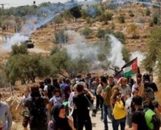
Israeli soldiers injured, Friday, a Palestinian child, after the army attacked the weekly nonviolent procession in Kufur Qaddoum village, east of the northern West Bank city of Qalqilia.
Medical sources said the soldiers shot the child, Mo’men Morad, 8, with a rubber-coated steel bullet in his abdomen.
Medics provided the child with the needed treatment without the need to hospitalize him.
The soldiers also fired gas bombs and concussion grenades at the protesters, who marched in solidarity with the Palestinian detainees, held by Israel, and demanding the army to reopen the main road, which was blockaded fifteen years ago to provide easy access to colonizers driving to and from Kedumim illegal colony, which was built on private Palestinian lands.
Medical sources said the soldiers shot the child, Mo’men Morad, 8, with a rubber-coated steel bullet in his abdomen.
Medics provided the child with the needed treatment without the need to hospitalize him.
The soldiers also fired gas bombs and concussion grenades at the protesters, who marched in solidarity with the Palestinian detainees, held by Israel, and demanding the army to reopen the main road, which was blockaded fifteen years ago to provide easy access to colonizers driving to and from Kedumim illegal colony, which was built on private Palestinian lands.

A Palestinian man, 65 years of age, was injured on Thursday evening, after Israeli soldiers stormed his home in Silwan town, in occupied Jerusalem, and abducted his son during a violent search of the property before hurling a concussion grenade at him. The soldiers also abducted a child during the invasion.
The Wadi Hilweh Information Center in Silwan (Silwanic) has reported that the soldiers stormed the home of Ziad Zidani, 65, in the al-Bustan neighborhood, before assaulting him and his family while ransacking the property.
It added that the soldiers hurled a concussion grenade at the man, striking him in his leg, causing various cuts and bruises.
The soldiers also invaded and searched many homes in the town, especially in the al-Ein Street, al-Bustan and al-Westa neighborhoods, installed many roadblocks and hurled concussion grenades at the residents.
In addition, the army abducted a child, identified as Mohammad Abu Rajab, from his home in al-Westa neighborhood. Video
The Wadi Hilweh Information Center in Silwan (Silwanic) has reported that the soldiers stormed the home of Ziad Zidani, 65, in the al-Bustan neighborhood, before assaulting him and his family while ransacking the property.
It added that the soldiers hurled a concussion grenade at the man, striking him in his leg, causing various cuts and bruises.
The soldiers also invaded and searched many homes in the town, especially in the al-Ein Street, al-Bustan and al-Westa neighborhoods, installed many roadblocks and hurled concussion grenades at the residents.
In addition, the army abducted a child, identified as Mohammad Abu Rajab, from his home in al-Westa neighborhood. Video
22 apr 2018 Land day
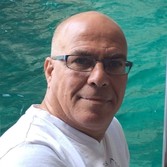
Zvika Fogel
An Israeli general has confirmed that when snipers stationed along Israel’s boundary with Gaza shoot at children, they are doing so deliberately, under clear and specific orders.
In a radio interview, Brigadier-General (Reserve) Zvika Fogel describes how a sniper identifies the “small body” of a child and is given authorization to shoot.
Fogel’s statements could be used as evidence of intent if Israeli leaders are ever tried for war crimes at the International Criminal Court.
On Friday, an Israeli sniper shot dead 14-year-old Muhammad Ibrahim Ayyoub.
The boy, shot in the head east of Jabaliya, was the fourth child among the more than 30 Palestinians killed during the Great March of Return rallies that began in Gaza on 30 March.
More than 1,600 other Palestinians have been shot with live ammunition that has caused what doctors are calling “horrific injuries” likely to leave many of them with permanent disabilities.
As eyewitnesses and video confirmed, the child Muhammad Ayyoub posed no conceivable danger to heavily armed Israeli occupation forces stationed dozens of meters away behind fences and earthen fortifications on the other side of the Gaza boundary when he was killed.
Even the usually timid United Nations peace process envoy Nickolay Mladenov publicly declared that the slaying was “outrageous.”
Targeting children
On Saturday, Brigadier-General Fogel was interviewed by Ron Nesiel on the Israeli public radio network Kan.
Fogel is the former chief of staff of the Israeli army’s “southern command,” which includes the occupied Gaza Strip.
Ahmad Tibi, a Palestinian lawmaker in Israel’s parliament, drew attention to the interview in a tweet.
A recording of the interview is online (it begins at 6:52). The interview was translated for The Electronic Intifada by Dena Shunra and a full transcript follows this article.
The host Ron Nesiel asks Fogel if the Israeli army should “rethink its use of snipers,” and suggests that someone giving orders “lowered the bar for using live fire.”
Fogel adamantly defends the policy, stating: “At the tactical level, any person who gets close to the fence, anyone who could be a future threat to the border of the State of Israel and its residents, should bear a price for that violation.”
He adds: “If this child or anyone else gets close to the fence in order to hide an explosive device or check if there are any dead zones there or to cut the fence so someone could infiltrate the territory of the State of Israel to kill us …”
“Then his punishment is death?” Nesiel interjects.
“His punishment is death,” the general responds. “As far as I’m concerned then yes, if you can only shoot him to stop him, in the leg or arm – great. But if it’s more than that then, yes, you want to check with me whose blood is thicker, ours or theirs.”
Fogel then describes the careful process by which targets – including children – are identified and shot:
“I know how these orders are given. I know how a sniper does the shooting. I know how many authorizations he needs before he receives an authorization to open fire. It is not the whim of one or the other sniper who identifies the small body of a child now and decides he’ll shoot. Someone marks the target for him very well and tells him exactly why one has to shoot and what the threat is from that individual. And to my great sorrow, sometimes when you shoot at a small body and you intended to hit his arm or shoulder, it goes even higher.”
For “it goes even higher,” Fogel uses a Hebrew idiom also meaning “it costs even more.”
In this chilling statement, in which a general talks about snipers targeting the “small body of a child,” Fogel makes crystal clear that this policy is premeditated and deliberate.
While presenting unarmed Palestinian children as dangerous terrorists worthy of death, Fogel describes the snipers killing them in cold blood as the innocent, vulnerable parties who deserve protection.
“We have soldiers there, our children, who were sent out and receive very accurate instructions about whom to shoot to protect us. Let’s back them up,” he says.
Lethal policy
Fogel’s statements are no aberration but represent Israeli policy.
“Israeli officials made it clear that the open-fire regulations would permit lethal fire at anyone attempting to damage the fence, and even at any person coming within 300 meters of it,” the Israeli human rights group B’Tselem stated [PDF] in a recent analysis of Israel’s illegal targeting of unarmed civilians who pose no threat.
“Nevertheless, all state and military officials have steadfastly refused to cancel the unlawful orders and continue to issue – and justify – them,” B’Tselem added.
B’Tselem has called on individual soldiers to defy such illegal orders.
Following its investigation of the “calculated” killings of unarmed demonstrators on 30 March, the first day of the Great March of Return rallies in Gaza, Human Rights Watch concluded that the lethal crackdown was “planned at [the] highest levels of the Israeli government.”
Two weeks ago, the chief prosecutor of the International Criminal Court issued an unprecedented warning that Israeli leaders may face trial for the killings of unarmed Palestinian protesters in the Gaza Strip.
Potential defendants would be giving any prosecutor a gift with such open admissions that killing unarmed people in an occupied territory who pose no objective threat is their policy and intent.
The question remains whether anything will finally pierce the shield of impunity that Israel has enjoyed for 70 years.
Full Transcript
Brigadier-General (Res.) Zvika Fogel interviewed on the Yoman Hashevua program of Israel’s Kan radio, 21 April 2018.
Ron Nesiel: Greetings Brigadier General (Res.) Zvika Fogel. Should the IDF [Israeli army] rethink its use of snipers? There’s the impression that maybe someone lowered the bar for using live fire, and this may be the result?
Zvika Fogel: Ron, let’s maybe look at this matter on three levels. At the tactical level that we all love dealing with, the local one, also at the level of values, and with your permission, we will also rise up to the strategic level. At the tactical level, any person who gets close to the fence, anyone who could be a future threat to the border of the State of Israel and its residents, should bear a price for that violation. If this child or anyone else gets close to the fence in order to hide an explosive device or check if there are any dead zones there or to cut the fence so someone could infiltrate the territory of the State of Israel to kill us …
Nesiel: Then, then his punishment is death?
Fogel: His punishment is death. As far as I’m concerned then yes, if you can only shoot him to stop him, in the leg or arm – great. But if it’s more than that then, yes, you want to check with me whose blood is thicker, ours or theirs. It is clear to you that if one such person will manage to cross the fence or hide an explosive device there …
Nesiel: But we were taught that live fire is only used when the soldiers face immediate danger.
Fogel: Come, let’s move over to the level of values. Assuming that we understood the tactical level, as we cannot tolerate a crossing of our border or a violation of our border, let’s proceed to the level of values. I am not Ahmad Tibi, I am Zvika Fogel. I know how these orders are given. I know how a sniper does the shooting. I know how many authorizations he needs before he receives an authorization to open fire. It is not the whim of one or the other sniper who identifies the small body of a child now and decides he’ll shoot. Someone marks the target for him very well and tells him exactly why one has to shoot and what the threat is from that individual. And to my great sorrow, sometimes when you shoot at a small body and you intended to hit his arm or shoulder it goes even higher. The picture is not a pretty picture. But if that’s the price that we have to pay to preserve the safety and quality of life of the residents of the State of Israel, then that’s the price. But now, with your permission, let us go up one level and look at the overview. It is clear to you that Hamas is fighting for consciousness at the moment. It is clear to you and to me …
Nesiel: Is it hard for them to do? Aren’t we providing them with sufficient ammunition in this battle?
Fogel: We’re providing them but …
Nesiel: Because it does not do all that well for us, those pictures that are distributed around the world.
Fogel: Look, Ron, we’re even terrible at it. There’s nothing to be done, David always looks better against Goliath. And in this case, we are the Goliath. Not the David. That is entirely clear to me. But let’s look at it at the strategic level: you and I and a large part of the listeners are clear that this will not end up in demonstrations. It is clear to us that Hamas can’t continue to tolerate the fact that its rockets are not managing to hurt us, its tunnels are eroding …
Nesiel: Yes.
Fogel: And it doesn’t have too many suicide bombers who continue to believe the fairytale about the virgins waiting up there. It will drag us into a war. I do not want to be on the side that gets dragged. I want to be on the side that initiates things. I do not want to wait for the moment where it finds a weak spot and attacks me there. If tomorrow morning it gets into a military base or a kibbutz and kills people there and takes prisoners of war or hostages, call it as you like, we’re in a whole new script. I want the leaders of Hamas to wake up tomorrow morning and for the last time in their life see the smiling faces of the IDF. That’s what I want to have happen. But we are dragged along. So we’re putting snipers up because we want to preserve the values we were educated by. We can’t always take a single picture and put it before the whole world. We have soldiers there, our children, who were sent out and receive very accurate instructions about whom to shoot to protect us. Let’s back them up.
Nesiel: Brigadier-General (Res.) Zvika Fogel, formerly Head of the Southern Command Staff, thank you for your words.
Fogel: May you only hear good news. Thank you.
An Israeli general has confirmed that when snipers stationed along Israel’s boundary with Gaza shoot at children, they are doing so deliberately, under clear and specific orders.
In a radio interview, Brigadier-General (Reserve) Zvika Fogel describes how a sniper identifies the “small body” of a child and is given authorization to shoot.
Fogel’s statements could be used as evidence of intent if Israeli leaders are ever tried for war crimes at the International Criminal Court.
On Friday, an Israeli sniper shot dead 14-year-old Muhammad Ibrahim Ayyoub.
The boy, shot in the head east of Jabaliya, was the fourth child among the more than 30 Palestinians killed during the Great March of Return rallies that began in Gaza on 30 March.
More than 1,600 other Palestinians have been shot with live ammunition that has caused what doctors are calling “horrific injuries” likely to leave many of them with permanent disabilities.
As eyewitnesses and video confirmed, the child Muhammad Ayyoub posed no conceivable danger to heavily armed Israeli occupation forces stationed dozens of meters away behind fences and earthen fortifications on the other side of the Gaza boundary when he was killed.
Even the usually timid United Nations peace process envoy Nickolay Mladenov publicly declared that the slaying was “outrageous.”
Targeting children
On Saturday, Brigadier-General Fogel was interviewed by Ron Nesiel on the Israeli public radio network Kan.
Fogel is the former chief of staff of the Israeli army’s “southern command,” which includes the occupied Gaza Strip.
Ahmad Tibi, a Palestinian lawmaker in Israel’s parliament, drew attention to the interview in a tweet.
A recording of the interview is online (it begins at 6:52). The interview was translated for The Electronic Intifada by Dena Shunra and a full transcript follows this article.
The host Ron Nesiel asks Fogel if the Israeli army should “rethink its use of snipers,” and suggests that someone giving orders “lowered the bar for using live fire.”
Fogel adamantly defends the policy, stating: “At the tactical level, any person who gets close to the fence, anyone who could be a future threat to the border of the State of Israel and its residents, should bear a price for that violation.”
He adds: “If this child or anyone else gets close to the fence in order to hide an explosive device or check if there are any dead zones there or to cut the fence so someone could infiltrate the territory of the State of Israel to kill us …”
“Then his punishment is death?” Nesiel interjects.
“His punishment is death,” the general responds. “As far as I’m concerned then yes, if you can only shoot him to stop him, in the leg or arm – great. But if it’s more than that then, yes, you want to check with me whose blood is thicker, ours or theirs.”
Fogel then describes the careful process by which targets – including children – are identified and shot:
“I know how these orders are given. I know how a sniper does the shooting. I know how many authorizations he needs before he receives an authorization to open fire. It is not the whim of one or the other sniper who identifies the small body of a child now and decides he’ll shoot. Someone marks the target for him very well and tells him exactly why one has to shoot and what the threat is from that individual. And to my great sorrow, sometimes when you shoot at a small body and you intended to hit his arm or shoulder, it goes even higher.”
For “it goes even higher,” Fogel uses a Hebrew idiom also meaning “it costs even more.”
In this chilling statement, in which a general talks about snipers targeting the “small body of a child,” Fogel makes crystal clear that this policy is premeditated and deliberate.
While presenting unarmed Palestinian children as dangerous terrorists worthy of death, Fogel describes the snipers killing them in cold blood as the innocent, vulnerable parties who deserve protection.
“We have soldiers there, our children, who were sent out and receive very accurate instructions about whom to shoot to protect us. Let’s back them up,” he says.
Lethal policy
Fogel’s statements are no aberration but represent Israeli policy.
“Israeli officials made it clear that the open-fire regulations would permit lethal fire at anyone attempting to damage the fence, and even at any person coming within 300 meters of it,” the Israeli human rights group B’Tselem stated [PDF] in a recent analysis of Israel’s illegal targeting of unarmed civilians who pose no threat.
“Nevertheless, all state and military officials have steadfastly refused to cancel the unlawful orders and continue to issue – and justify – them,” B’Tselem added.
B’Tselem has called on individual soldiers to defy such illegal orders.
Following its investigation of the “calculated” killings of unarmed demonstrators on 30 March, the first day of the Great March of Return rallies in Gaza, Human Rights Watch concluded that the lethal crackdown was “planned at [the] highest levels of the Israeli government.”
Two weeks ago, the chief prosecutor of the International Criminal Court issued an unprecedented warning that Israeli leaders may face trial for the killings of unarmed Palestinian protesters in the Gaza Strip.
Potential defendants would be giving any prosecutor a gift with such open admissions that killing unarmed people in an occupied territory who pose no objective threat is their policy and intent.
The question remains whether anything will finally pierce the shield of impunity that Israel has enjoyed for 70 years.
Full Transcript
Brigadier-General (Res.) Zvika Fogel interviewed on the Yoman Hashevua program of Israel’s Kan radio, 21 April 2018.
Ron Nesiel: Greetings Brigadier General (Res.) Zvika Fogel. Should the IDF [Israeli army] rethink its use of snipers? There’s the impression that maybe someone lowered the bar for using live fire, and this may be the result?
Zvika Fogel: Ron, let’s maybe look at this matter on three levels. At the tactical level that we all love dealing with, the local one, also at the level of values, and with your permission, we will also rise up to the strategic level. At the tactical level, any person who gets close to the fence, anyone who could be a future threat to the border of the State of Israel and its residents, should bear a price for that violation. If this child or anyone else gets close to the fence in order to hide an explosive device or check if there are any dead zones there or to cut the fence so someone could infiltrate the territory of the State of Israel to kill us …
Nesiel: Then, then his punishment is death?
Fogel: His punishment is death. As far as I’m concerned then yes, if you can only shoot him to stop him, in the leg or arm – great. But if it’s more than that then, yes, you want to check with me whose blood is thicker, ours or theirs. It is clear to you that if one such person will manage to cross the fence or hide an explosive device there …
Nesiel: But we were taught that live fire is only used when the soldiers face immediate danger.
Fogel: Come, let’s move over to the level of values. Assuming that we understood the tactical level, as we cannot tolerate a crossing of our border or a violation of our border, let’s proceed to the level of values. I am not Ahmad Tibi, I am Zvika Fogel. I know how these orders are given. I know how a sniper does the shooting. I know how many authorizations he needs before he receives an authorization to open fire. It is not the whim of one or the other sniper who identifies the small body of a child now and decides he’ll shoot. Someone marks the target for him very well and tells him exactly why one has to shoot and what the threat is from that individual. And to my great sorrow, sometimes when you shoot at a small body and you intended to hit his arm or shoulder it goes even higher. The picture is not a pretty picture. But if that’s the price that we have to pay to preserve the safety and quality of life of the residents of the State of Israel, then that’s the price. But now, with your permission, let us go up one level and look at the overview. It is clear to you that Hamas is fighting for consciousness at the moment. It is clear to you and to me …
Nesiel: Is it hard for them to do? Aren’t we providing them with sufficient ammunition in this battle?
Fogel: We’re providing them but …
Nesiel: Because it does not do all that well for us, those pictures that are distributed around the world.
Fogel: Look, Ron, we’re even terrible at it. There’s nothing to be done, David always looks better against Goliath. And in this case, we are the Goliath. Not the David. That is entirely clear to me. But let’s look at it at the strategic level: you and I and a large part of the listeners are clear that this will not end up in demonstrations. It is clear to us that Hamas can’t continue to tolerate the fact that its rockets are not managing to hurt us, its tunnels are eroding …
Nesiel: Yes.
Fogel: And it doesn’t have too many suicide bombers who continue to believe the fairytale about the virgins waiting up there. It will drag us into a war. I do not want to be on the side that gets dragged. I want to be on the side that initiates things. I do not want to wait for the moment where it finds a weak spot and attacks me there. If tomorrow morning it gets into a military base or a kibbutz and kills people there and takes prisoners of war or hostages, call it as you like, we’re in a whole new script. I want the leaders of Hamas to wake up tomorrow morning and for the last time in their life see the smiling faces of the IDF. That’s what I want to have happen. But we are dragged along. So we’re putting snipers up because we want to preserve the values we were educated by. We can’t always take a single picture and put it before the whole world. We have soldiers there, our children, who were sent out and receive very accurate instructions about whom to shoot to protect us. Let’s back them up.
Nesiel: Brigadier-General (Res.) Zvika Fogel, formerly Head of the Southern Command Staff, thank you for your words.
Fogel: May you only hear good news. Thank you.
19 apr 2018 Land day
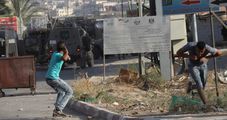
Clashes burst out on Thursday evening between the Israeli occupation forces and Palestinian anti-occupation youth in Qalqilya’s eastern town of Azzoun, in the northern West Bank.
According to local sources, heavily-armed Israeli soldiers chased down Palestinian youth near the main entrance to Azzoun town and raked through olive groves.
Palestinian anti-occupation protesters responded to the crackdown by hurling stones at Israeli settlers’ cars parked in the area.
At the same time, heavily-armed Israeli patrols rolled into the nearby Gios town and set up a military checkpoint, before they cracked down on Palestinians passing through the area.
A Palestinian boy had reportedly been made to endure heavy beating while several Palestinians have had their vehicles seized in the assault.
According to local sources, heavily-armed Israeli soldiers chased down Palestinian youth near the main entrance to Azzoun town and raked through olive groves.
Palestinian anti-occupation protesters responded to the crackdown by hurling stones at Israeli settlers’ cars parked in the area.
At the same time, heavily-armed Israeli patrols rolled into the nearby Gios town and set up a military checkpoint, before they cracked down on Palestinians passing through the area.
A Palestinian boy had reportedly been made to endure heavy beating while several Palestinians have had their vehicles seized in the assault.
18 apr 2018 Land day
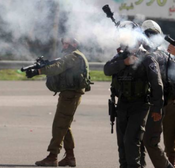
Israeli forces, Wednesday, physically assaulted three Palestinian journalists during clashes that broke out in al-‘Arroub refugee camp, north of the southern West Bank district of Hebron, said security sources.
Sources told WAFA Israeli soldiers physically assaulted three journalists while they were covering confronatations that erupted near the Palestine technical college, near the camp.
The journalists were identified as Mohammad Halayqa, Mus’ab Shawar, and Sari Jaradat. Meanwhile, two Palestinian youth were reportedly detained during the clashes.
Israeli settlers attacked Palestinian students on their way home from school in al-Salaymeh neighborhood in the Old City district of Hebron, in the southern West Bank, local sources also reported, according to WAFA.
The settlers physically attacked students and used foul language against them, but no injuries were reported.
Israeli forces also attacked high school students from al-Sawiya al-Lubban high school, to the south of Nablus, with pepper spray, causing a number of them to suffocate, said a local official.
Ghassan Daghlas, who monitors settlement activities in northern West Bank district, said that Israeli soldiers sprayed students with pepper spray while they were heading back home from school.
Several students suffered from suffocation, including one case that necessitated transfer to hospital for medical treatment.
Sources told WAFA Israeli soldiers physically assaulted three journalists while they were covering confronatations that erupted near the Palestine technical college, near the camp.
The journalists were identified as Mohammad Halayqa, Mus’ab Shawar, and Sari Jaradat. Meanwhile, two Palestinian youth were reportedly detained during the clashes.
Israeli settlers attacked Palestinian students on their way home from school in al-Salaymeh neighborhood in the Old City district of Hebron, in the southern West Bank, local sources also reported, according to WAFA.
The settlers physically attacked students and used foul language against them, but no injuries were reported.
Israeli forces also attacked high school students from al-Sawiya al-Lubban high school, to the south of Nablus, with pepper spray, causing a number of them to suffocate, said a local official.
Ghassan Daghlas, who monitors settlement activities in northern West Bank district, said that Israeli soldiers sprayed students with pepper spray while they were heading back home from school.
Several students suffered from suffocation, including one case that necessitated transfer to hospital for medical treatment.
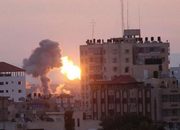
Israeli soldiers fired, on Wednesday at dawn, at least two artillery shells into Palestinian lands, close to the border fence east of Khuza’a town, east of Khan Younis, in the southern part of the Gaza Strip, wounding five Palestinians, including one who suffered a serious injury.
Media sources said the soldiers, stationed across the border fence east of Khuza’a town, fired at least two shells at Palestinians who approached the border fence, wounding five; one seriously.
They added that the soldiers also fired several live rounds at Red Crescent ambulances and medics who rushed to the scene.
On Tuesday evening, the soldiers shot and injured five Palestinians, including one child, during a nonviolent procession near the border fence.
The army also fired artillery shells into a site, east of the al-Boreij refugee camp, in central Gaza.
* 8 apr 2018: Haaretz: Israel may strike Hamas targets to stop border protests
Media sources said the soldiers, stationed across the border fence east of Khuza’a town, fired at least two shells at Palestinians who approached the border fence, wounding five; one seriously.
They added that the soldiers also fired several live rounds at Red Crescent ambulances and medics who rushed to the scene.
On Tuesday evening, the soldiers shot and injured five Palestinians, including one child, during a nonviolent procession near the border fence.
The army also fired artillery shells into a site, east of the al-Boreij refugee camp, in central Gaza.
* 8 apr 2018: Haaretz: Israel may strike Hamas targets to stop border protests
